As part of the celebration of the 70th anniversary of Topps baseball cards, we've asked fans (as well as our staff) to submit their all-time favorite baseball cards, and we've broken them down by team. We'll be revealing submissions regularly throughout the season, ranging from the famous to the weird, and everything in between.
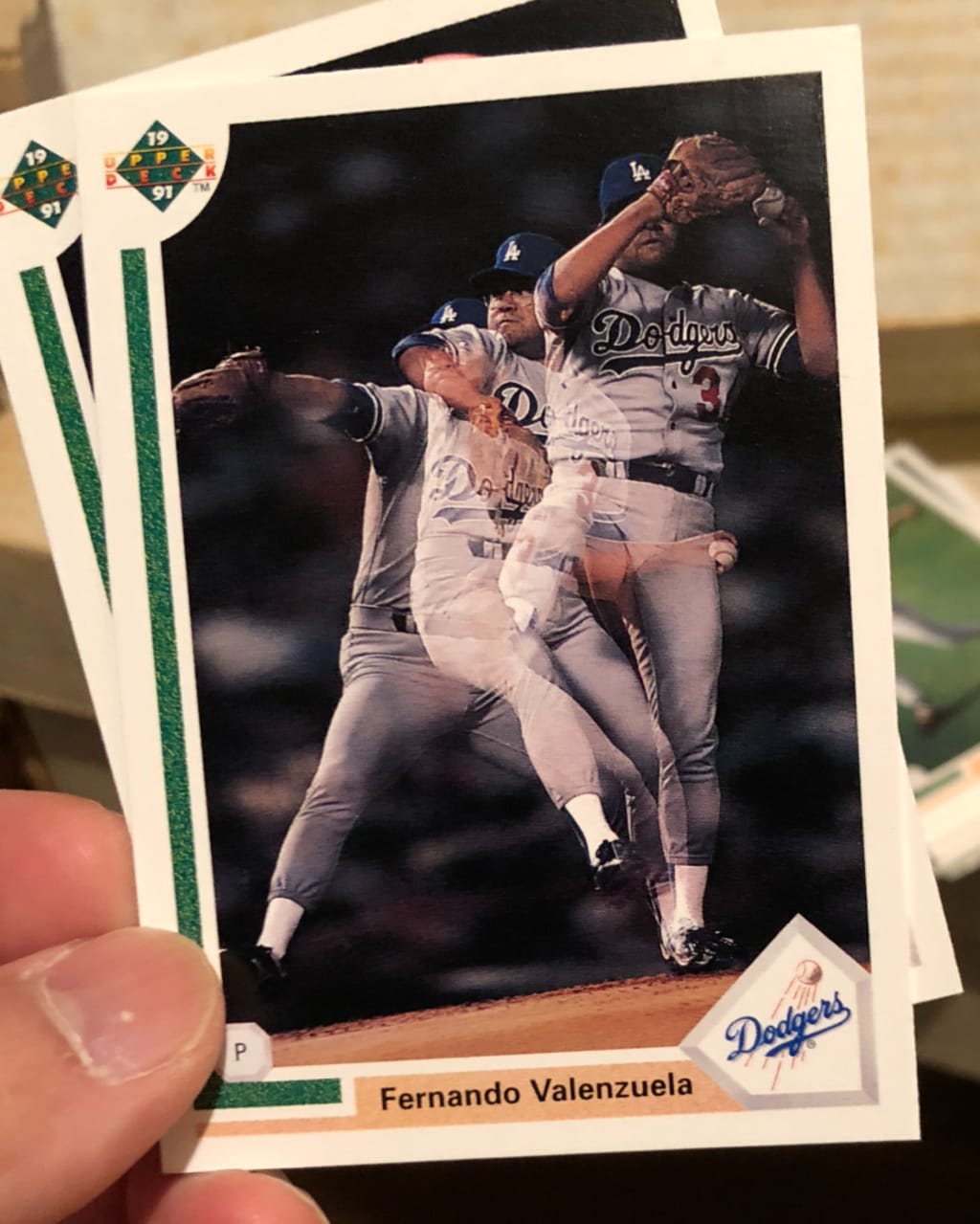
Fernando Valenzuela, 1991 Upper Deck
Valenzuela, who was the inspiration for Fernandomania in Los Angeles with an incredible run of shutouts in his 1981 rookie campaign, had one of the most unique windups in baseball history. He’d “look to the sky,” as legendary announcer Vin Scully described it, while in the middle of the delivery, before releasing each pitch.
So what better way to put Valenzuela on a baseball card than by following his windup and delivery all the way through in a cool visual display? Upper Deck was known for being very creative during the heyday of memorabilia collecting in the late 1980s, and the 1989 set featured several of these types of “in motion” offerings.
This one is extra special given the famed delivery Valenzuela introduced to us, as well as the memories it evokes for so many Dodgers fans of the summer of ’81, a season which ultimately ended with a World Series title for Los Angeles. -- Manny Randhawa
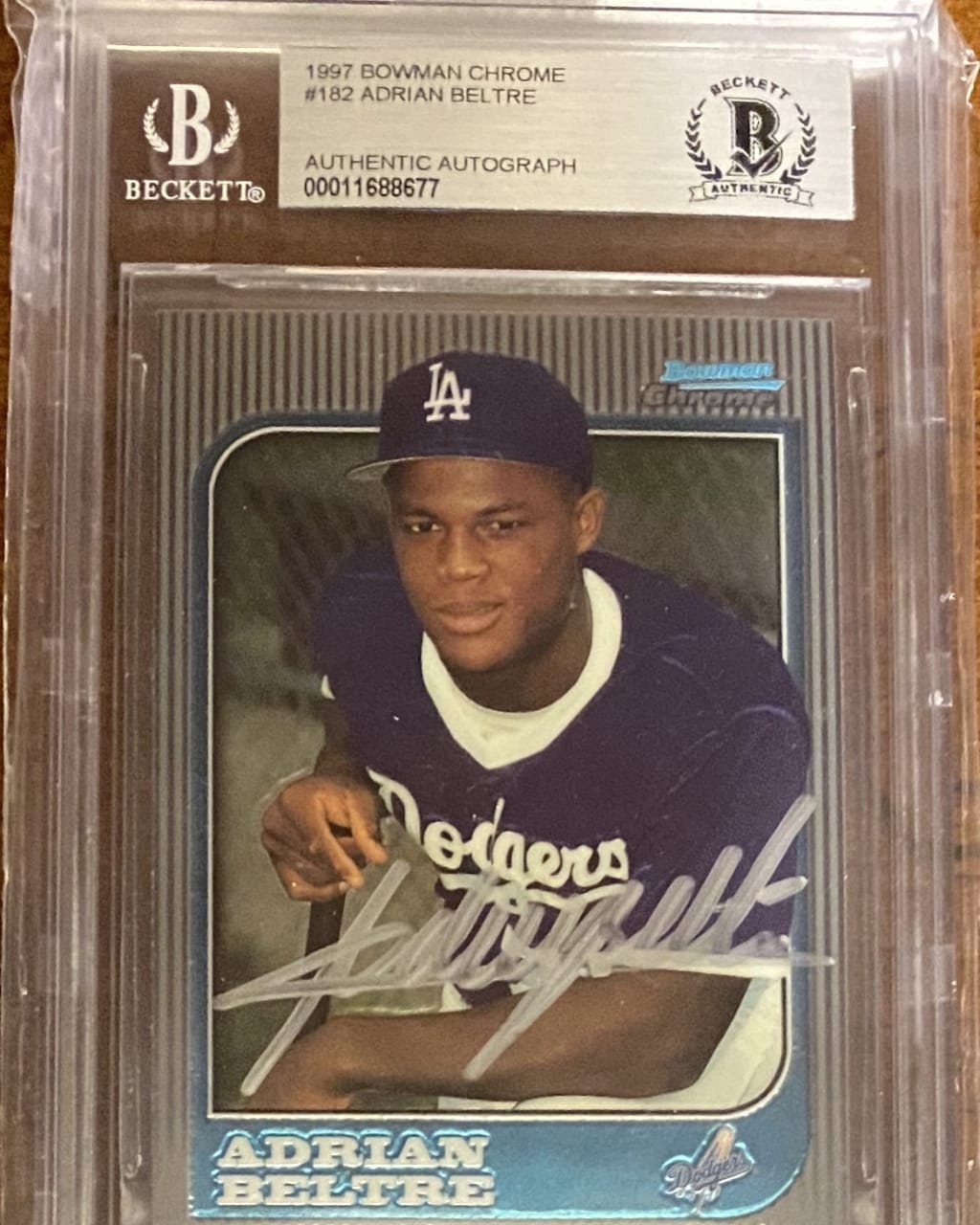
Adrián Beltré, 1997 Bowman Chrome
Before he was a surefire Hall of Famer, Beltré was a fresh-faced, 19-year-old kid making his debut for the Dodgers in 1998. And despite being a teenager in his 1997 Bowman Chrome photo, you wouldn’t be able to tell if he was 19 or 39, as he looks the same as he did when he retired in 2018.
Beltré only played 77 games his rookie year, hit just .215 and had an OPS of .648, not the numbers many think of when they look back on his career. His seven-year tenure with the Dodgers was a roller-coaster performance-wise, but was capped off with an incredible 2004 season when he slugged 48 home runs and finished second in the NL MVP voting.
Father time was kind to Beltré though, not only with his complexion, but also with his baseball skills. Like a fine wine, he only got better with age. He had a higher batting average after turning 30 than he did in his first 11 seasons, and six of his top seven seasons by bWAR came after the age of 31.
Beltré would also go on to become one of the best players to hail from the Dominican Republic, as he was the first Dominican-born player to join the 3,000-hit club and retired as the country’s all-time hit leader. He ranks second all-time in hits by a Dominican player, behind only Albert Pujols.
-- Nick Aguilera
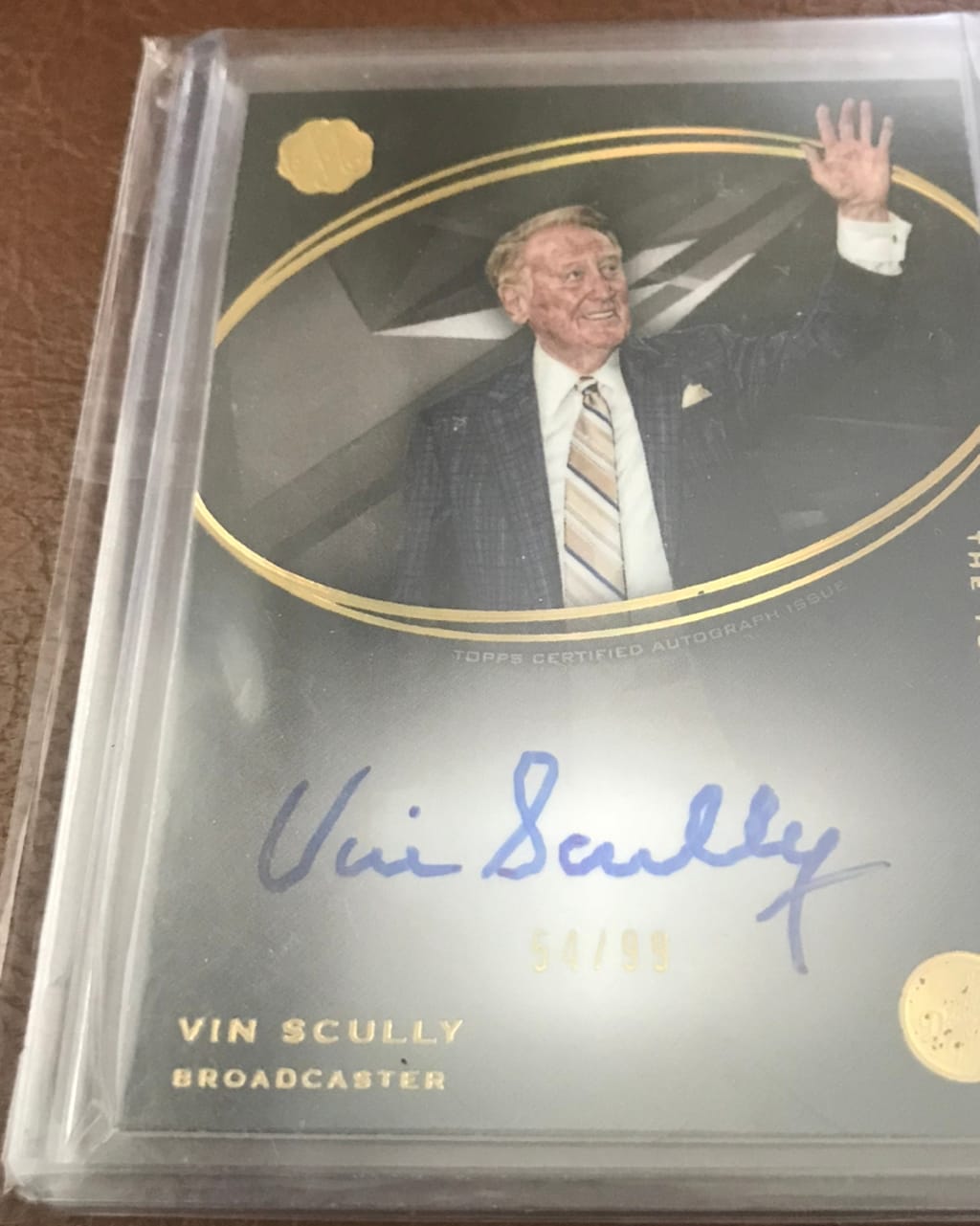
Vin Scully, 2016 Topps autograph
If there was ever a baseball card that could capture the greatness of the greatest play-by-play broadcaster in the game’s history, this is it. What a gem.
Scully broadcast Dodgers games from 1950-2016, moving with the Dodgers from Brooklyn to Los Angeles in 1958. His tenure spanned from legends like Jackie Robinson all the way to current stars like Clayton Kershaw.
This card is very apt for Scully, with a classy and sleek look all the way around, including gold trim around the image of Scully and both his name and the Dodgers logo.
This card was submitted by Josh J. of Dallas, Texas, who wrote about just how much he loves the card and his heartbreak at having to let it go.
“This was the most excited I’ve ever been about any baseball card,” he wrote. “I mean, come on, it’s Vin Scully. I have always wanted to meet him. So having this card was almost as thrilling. Unfortunately, I had to sell this card to help through a lean time. And if I ever get the opportunity to own it again, I won’t be letting it go!” -- Manny Randhawa

Sandy Koufax and Don Drysdale, 1965 Topps
Koufax and Drysdale were synonymous with pitching dominance in the ‘50s and ‘60s. The Dodgers’ twin aces helped the club win three World Series titles and combined for four Cy Young Awards in their 11 seasons together.
In ‘64, the duo finished first and second in the National League in ERA, as Koufax put up a 1.75 ERA and Drysdale had a 2.18 mark.
The next year, Topps’ ‘64 NL ERA leaders card (submitted by Ron Rimmon) was an all-Dodgers affair -- Koufax on top, Drysdale on the bottom, surrounded by a Dodger blue border. Classic. -- Thomas Harrigan
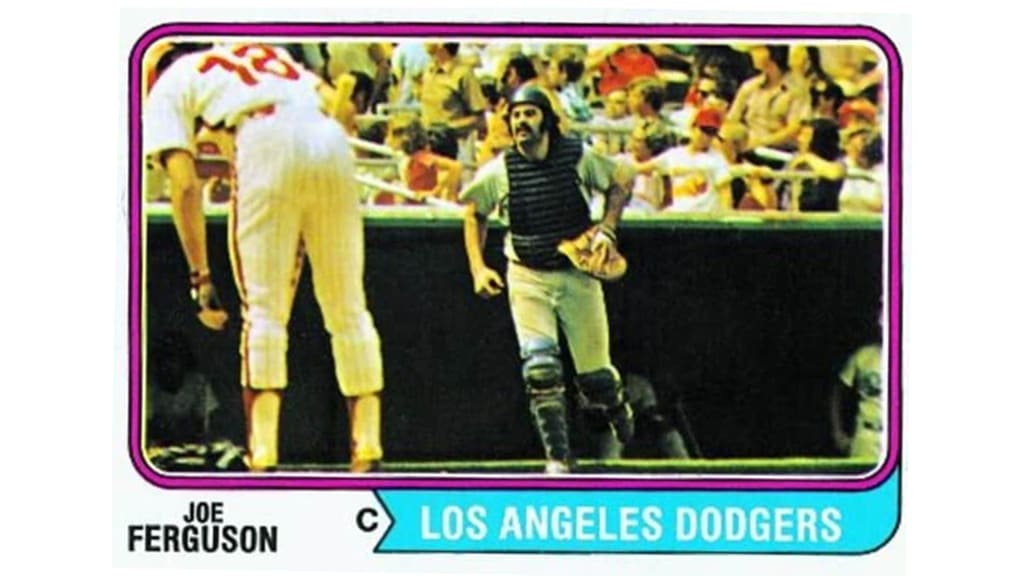
Best Dodgers facial hair card: Joe Ferguson, 1974 Topps
Ferguson was a solid catcher who enjoyed a 14-year MLB career spent with the Dodgers, Cardinals, Astros and Angels. He finished with a .358 career on-base percentage and played in two World Series, homering in Game 2 of the 1974 Fall Classic. And while he didn't sport facial hair his entire career, we have the privilege of seeing his tremendous handlebar mustache on this 1974 Topps card. -- Manny Randhawa

Gil Hodges, 1959 Topps
This one was submitted by Dodgers fan Jim Lloyd, who wrote:
"I was 9 years old [when I] discovered baseball and the Dodgers. My dad took me to my first Dodger game at the LA Coliseum. I loved Gil Hodges' No. 14, and that became my favorite number when I played."
The 1959 Topps set is instantly recognizable by its brightly colored borders, player names rendered in all lowercase type and unique circular images.
Hodges is depicted taking a swing while wearing the classic Dodgers home uniform and interlocking “LA” cap.
The 1959 season was the Dodgers’ second after moving from Brooklyn to Los Angeles and also Hodges’ last as a big league regular. He hit .276 with 25 homers and 80 RBIs in the regular season before posting a .391 average in the World Series as the Dodgers won their first title on the West Coast.
After two more seasons with the Dodgers, Hodges returned to New York with the expansion Mets. Hodges ended up managing the 1969 Mets to a stunning victory in the World Series and stayed on as the club’s skipper until his tragic passing from a heart attack in ‘72. -- Thomas Harrigan
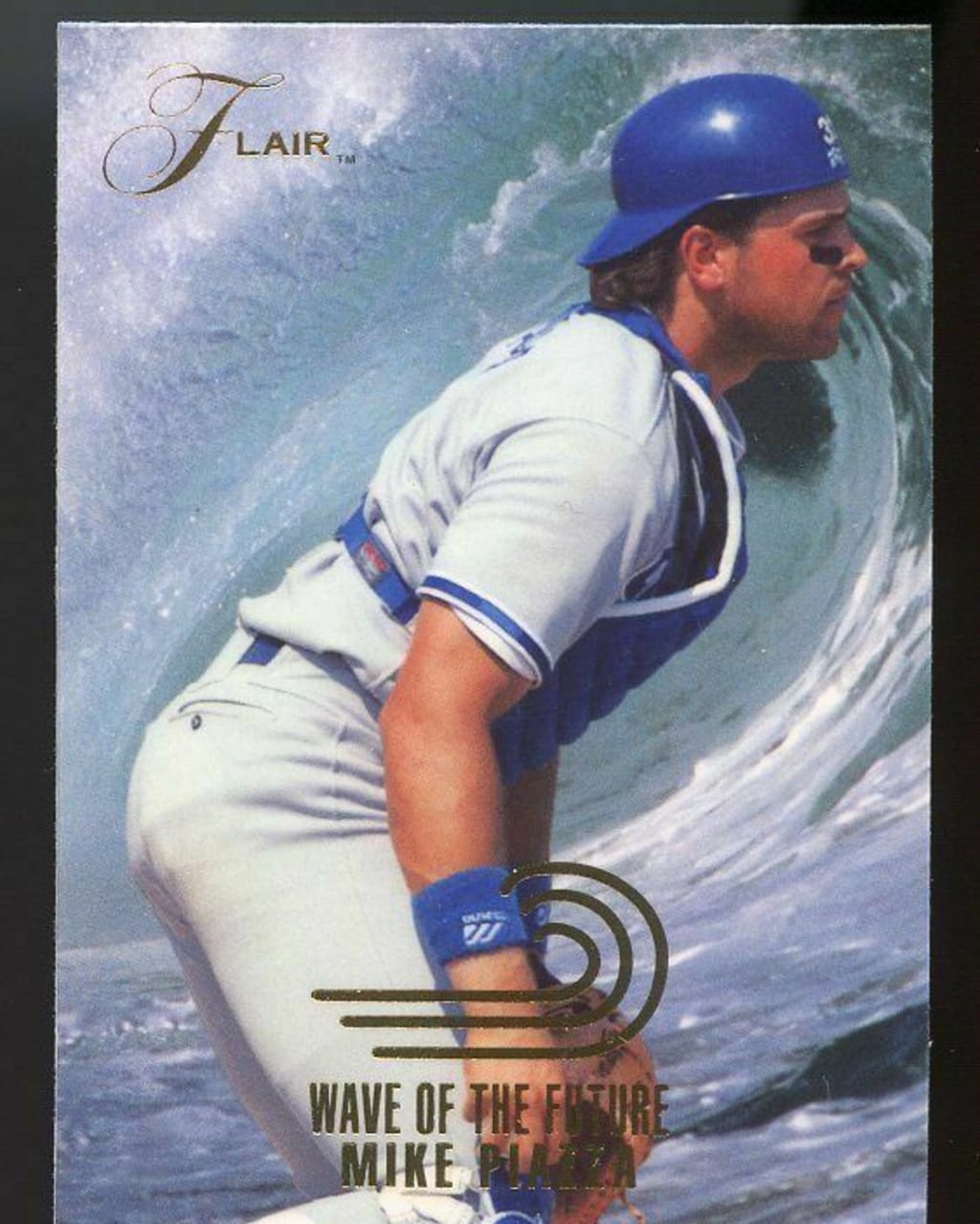
Mike Piazza, 1993 Flair
You have to love a card that reads “Wave of the Future” with an actual wave in the background and a player from the Los Angeles Dodgers on the front. Piazza isn’t actually surfing the Pacific Ocean in the photo, but any time a card indicates a player is part of “the wave of the future,” and that player becomes a Hall of Famer, the scouting reports were right on and it makes for a great keepsake.
Flair was a fancier card produced by Fleer, building upon its Fleer Ultra set to bring to the market a more premium card to compete with other brands. The 1993 set was relatively small -- 300 cards -- but they were beautiful, glossy and thicker than standard baseball cards and included the “Wave of the Future” set, which featured 20 future stars. Among them were Piazza, Manny Ramirez, Trevor Hoffman and others.
Our own Mets beat writer Anthony DiComo submitted this gem, noting that this was one of maybe half a dozen cards that he remembers vividly as an avid collector when he was a kid.
“I remember it vividly,” DiComo wrote. “Piazza standing in his catcher’s gear with a big ocean wave crashing over him. I just thought that card was so cool, and even though I wasn’t a Dodgers fan, I loved Piazza because he was a late-round Draft pick and an Italian-American. That was definitely a memorable card.” -- Manny Randhawa

Iconic Dodgers card: Jackie Robinson, 1956 Topps
What a tremendous card. Even though it is a 1956 Topps, issued in the year of Robinson's final season, it has perhaps the most iconic Robinson play on the front -- the steal of home. The artwork is brilliant, and there is his signature printed across the art and adjacent to a head shot of Robinson.
Robinson, of course, needs no introduction. He was a legend both on the field and off, breaking MLB's color barrier in 1947 and paving the way for Black players to finally have their chance to shine in the Majors. He endured horrific discrimination and persevered, and even with all of that on his shoulders, Robinson was one of the best players in the game. He was named Rookie of the Year in '47, receiving an award that now bears his name.
Robinson played 10 MLB seasons, was the 1949 National League Most Valuable Player -- also winning the batting average crown that year -- and was a six-time All-Star. He helped lead the Brooklyn Dodgers to their first World Series title in franchise history in '55, and was inducted into the Hall of Fame in '62. His number 42 is retired across baseball.
Robinson has such a hallowed place, not only in baseball lore but also in United States and world history, that any collectible of his is a cherished item. The 1956 Topps Robinson is no exception.
"I first saw this card in the mid '80s when I started collecting, and I immediately had to get one," wrote Victor D. of Los Angeles. "It's not his rookie or his rarest card, but I think it's hands down his best looking card and my all-time favorite ... and it still has the faint smell of bubble gum!"
The enormity of Robinson's legacy, which stretches far beyond the baseball diamond, is hard to fully comprehend. But whenever we can get our hands on a piece of Robinson memorabilia, what a privilege that is. With the 1956 Topps Robinson card, that memorabilia comes in the form of a gorgeously illustrated piece of art issued just before Robinson retired from the game.

Steve Garvey, 1977 Topps
Garvey was one of the best first basemen of his generation, winning an MVP Award in 1974 and making eight straight All-Star teams. He was one of the most popular Dodgers players in our survey.
Garvey’s 1977 Topps card was submitted by Rich B. of Mission Viejo, Calif., who wrote:
“I have been a huge Dodger fan since 1976 when I was 9 years old and Steve Garvey was always my favorite player. Watching Dodger games on Sunday with dad, hearing Vin Scully do the play-by-play was our second church. The reason I love this card was the entire design. I think it's a great picture of Steve playing first base with the large first baseman glove along with ‘DODGERS’ in large letters on top, N.L. ALL-STAR across the bottom, his position 1B in the pennant logo and a facsimile signature that doesn't interrupt the photo.” -- Thomas Harrigan
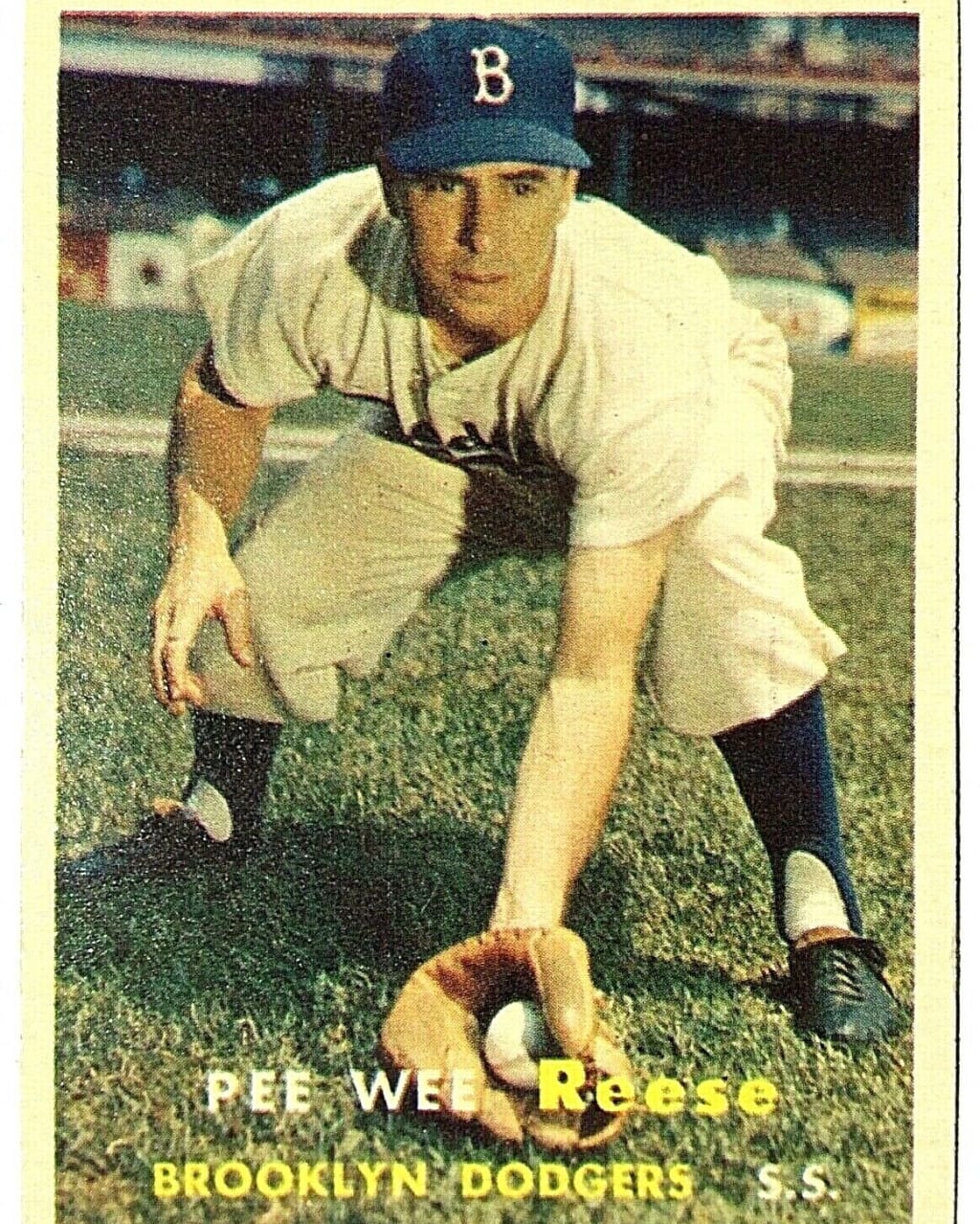
Pee Wee Reese, 1957 Topps
Reese is one of the most beloved Dodgers of all time -- the Hall of Fame shortstop was a 10-time All-Star and finished in the top 10 in National League MVP Award voting eight times in his 16-year career. He was also a key member of the 1955 Brooklyn Dodgers club that finally won the World Series in franchise history after losing in the Fall Classic four times over the previous eight years.
Bill B. of Budd Lake, New Jersey provided a detailed list of why this card is his all-time favorite:
"My favorite card is the 1957 Topps Pee Wee Reese because 1) He was the Brooklyn Dodgers' shortstop when I started following baseball as an 8-year-old in 1955 (obviously the year they won the World Series; 2) I was relatively small and the fact that Pee Wee was also short appealed to me; 3) I played shortstop for my Little League team; 4) Most importantly, about 1960, I created my own baseball game using dice -- I used three dice, and depending on the sum, things happened.
"I played this game, for hours, until 1963, my junior year in high school. When Maury Wills came up, there was no baseball card of him, so I took my old Pee Wee card and taped Maury's name over Pee Wee's and used Pee Wee's card for Maury. Thinking about the hours I spent playing my dice game and that my Dodgers always won my games and what great players both Pee Wee and Maury were, this card stands out as my favorite."

Steve Garvey 1978 Topps
When it comes to Dodgers legends, Garvey is often overlooked. The first baseman spent 14 seasons with the club, made eight straight All-Star teams (1974-81) and won the 1974 MVP Award.
Thanks to Kaleo Pahukula for submitting Garvey’s card from the 1978 Topps set in our survey.
“I was 7 when I started buying baseball cards, Garvey was my favorite player, and the All-Star shield on the ʻ78 cards sealed the deal for me,” Pahukula wrote. “I took the card with me on my first and only trip to Cooperstown in 2001.” -- Thomas Harrigan

Sandy Koufax, 1964 Topps
Cards commemorating a great moment in baseball history are special -- they're not standard cards you'd find in just any pack, and while Topps now produces "Topps Now" cards that commemorate lots of big moments in the game, such cards were much rarer decades ago.
This Koufax card is a fine example -- it celebrates his tremendous performance in Game 1 of the 1963 World Series against the Yankees at Yankee Stadium, when the legendary lefty struck out 15 in a 5-2 victory. That win set the tone for a sweep of the Bronx Bombers to give the Dodgers their second championship since moving to Los Angeles.
Thanks to Ross M. of Grimsby, Ontario, Canada, who submitted this gem in our survey.
"I was seven years old when I got this card," he wrote. "And it started a 57-year lifetime as a Dodgers fan." -- Manny Randhawa

Bill Russell, 1983 Topps
No, it’s not the 11-time NBA champion, but for Eric H. from Milford, NH, it must have felt like winning a Larry O’Brien trophy after he pulled the three-time All-Star’s 1983 card.
“1983 is the year I really got into collecting cards. I was 13 and for the first time viewed card collecting as a hobby and potential investment,” Eric wrote. “I remember trying to complete the 1983 Topps set and the only card I needed was Bill Russell. I must have bought and opened hundreds of packs when finally one day I was shuffling through a freshly opened pack and there he was.
“That moment of elation of satisfaction and accomplishment was amazing and even almost 38 years later gives me goosebumps.” -- Nick Aguilera
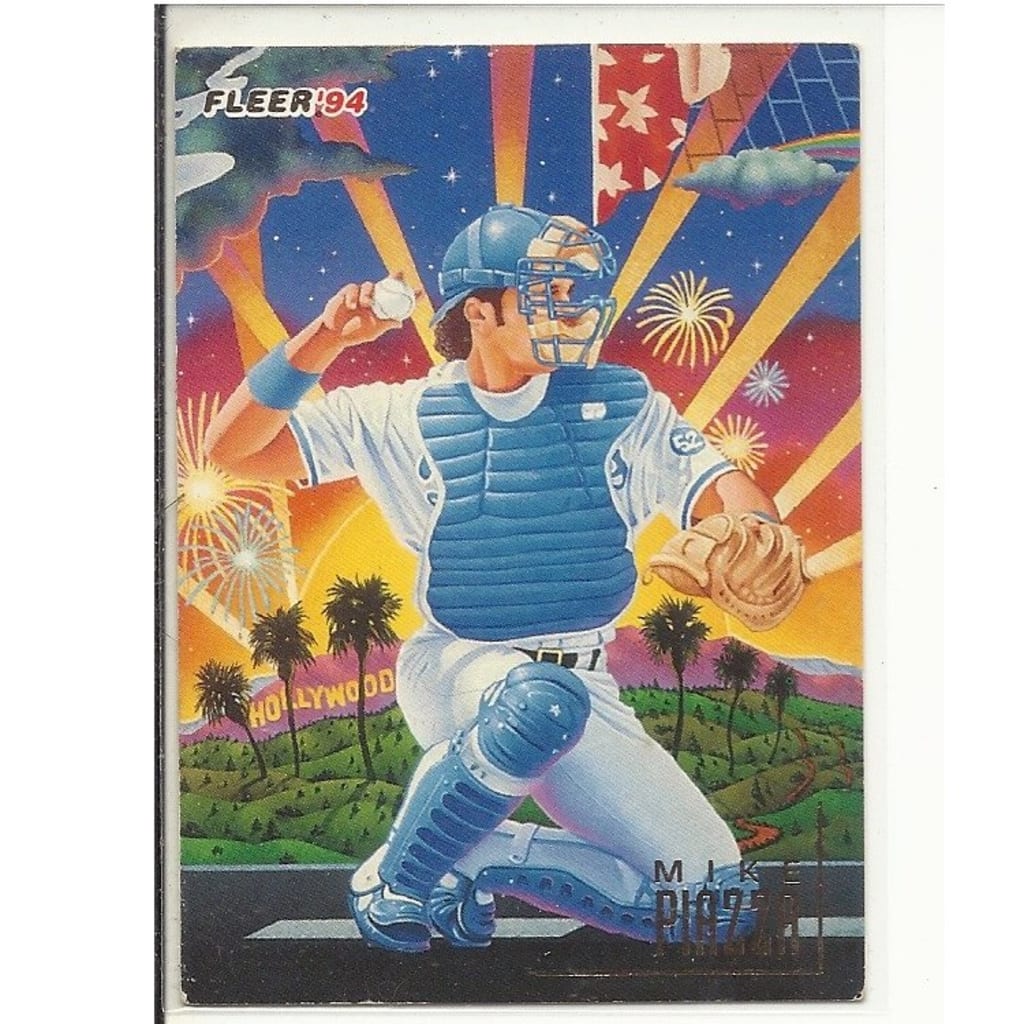
1990s throwback card: Mike Piazza, 1994 Fleer Pro-Visions
Fleer’s Pro-Visions were unique insert cards that featured fantasy-style artwork.
Piazza was included as part of the nine-card subset in 1994 after winning the NL Rookie of the Year Award the previous season.
The colorful card depicts Piazza in full catcher’s gear with the Hollywood Hills in the background, as the sun sets and fireworks decorate the sky.
There was added incentive to collect all nine cards in the subset, as they created a special composite image when placed together.
-- Thomas Harrigan
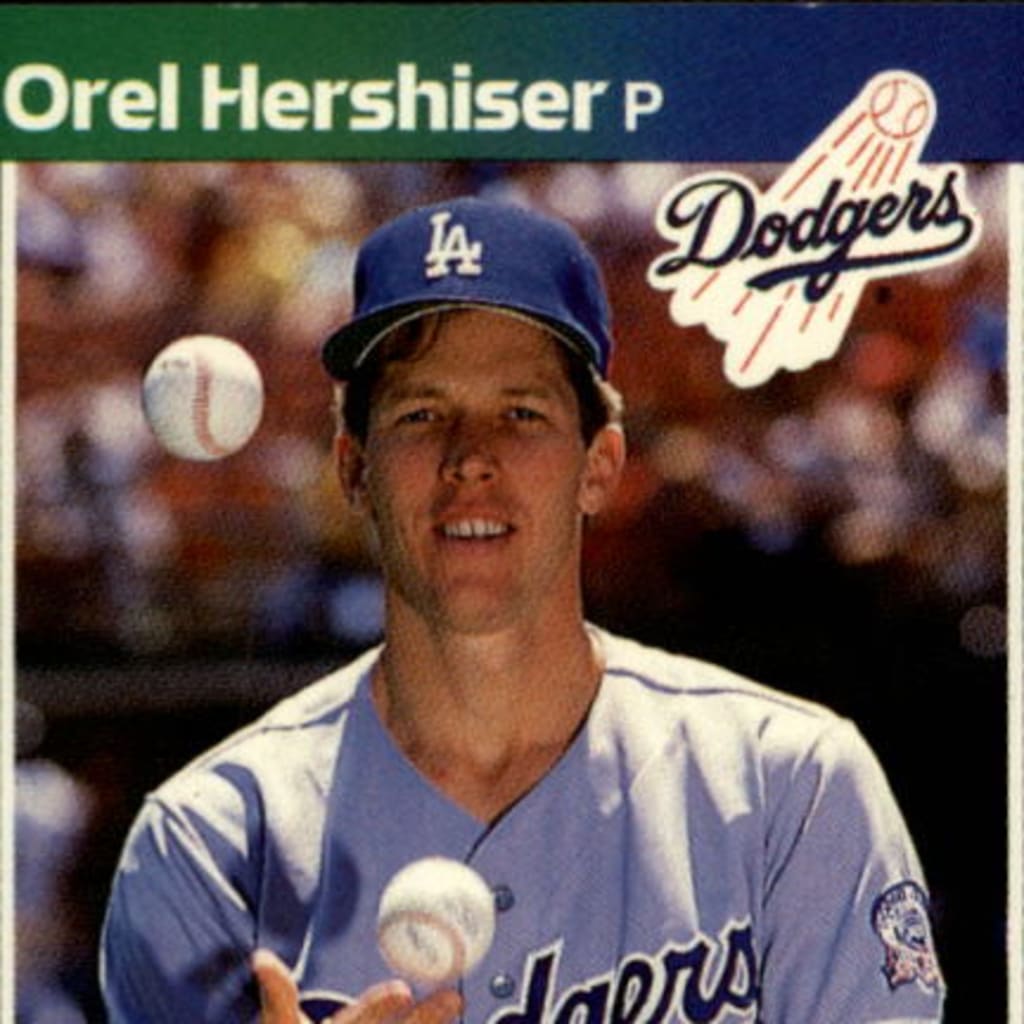
Orel Hershiser, 1989 Donruss
In 1988, Hershiser made MLB history by throwing 59 straight scoreless innings to finish out the season, breaking a record then held by another great Dodgers hurler, Don Drysdale.
Kevin G. of Sandia, N.M., submitted this card of Hershiser in our survey, and it's special to him not only for what's on the front regarding the record, but because Hershiser is his all-time favorite baseball player.
"I received his card in my first-ever pack of Topps and then 1988 happened, which made me a fan for life," Kevin wrote. "I used to trade just about anything to add to my Orel Hershiser collection and had over 50 of his cards. But my favorite was the '59 and counting' card that Donruss put out in 1989."
Though Hershiser's streak would end in his first start of '89, the record still stands today and this card from 1989 is a great reminder. And we get "Bulldog" juggling baseballs as a bonus! -- Manny Randhawa

Fred McGriff, 2004 Topps
The Crime Dog really was in L.A., it's true.
McGriff signed with the Dodgers for one season at the tail end of his career. He was 39 years old and had already hit 478 of his 493 career home runs.
He hit 13 more while playing first base for the Dodgers in 2003. This Topps card helps jog your memory about what the lefty slugger looked like in a Dodgers uniform.
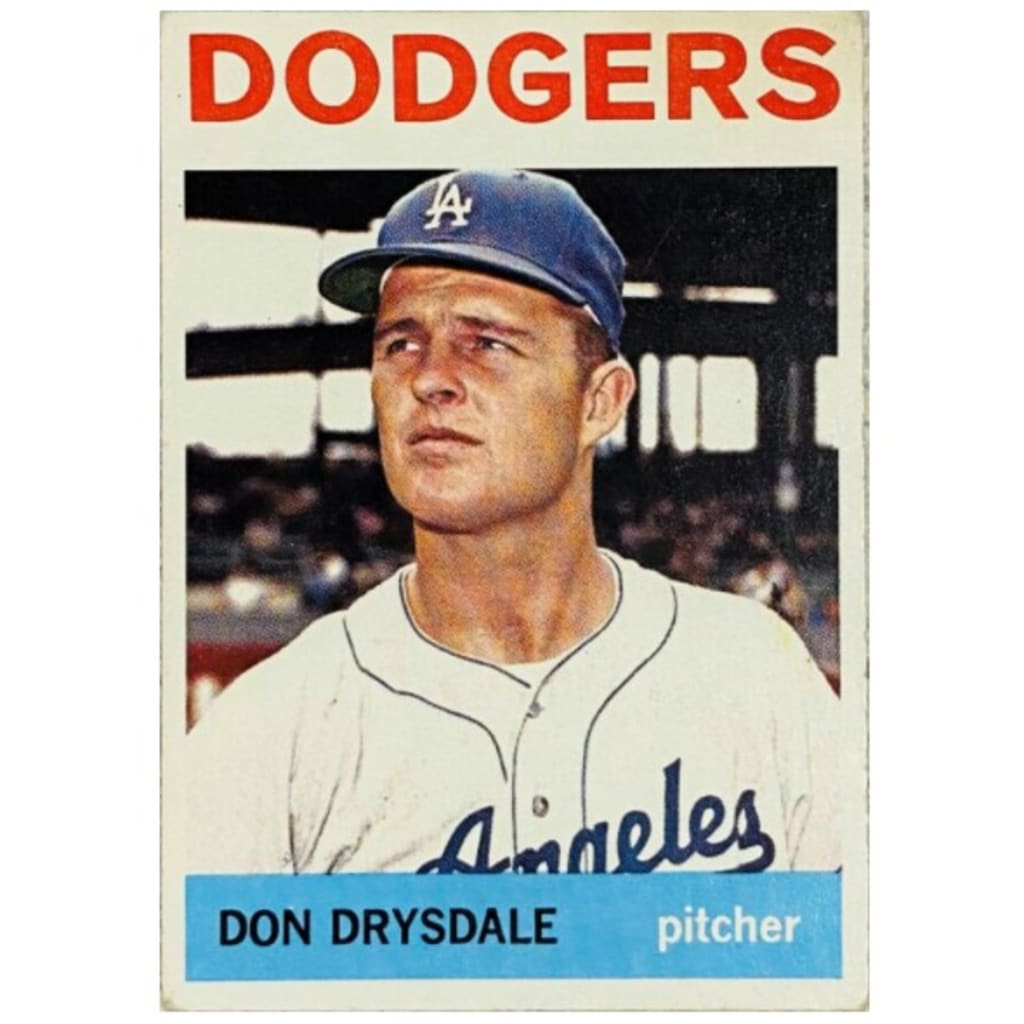
Don Drysdale, 1964 Topps
While the ‘64 Topps set features a clean, simplistic design, the large team nickname at the top and contrasting banner on the bottom prevents the cards from being boring.
The Dodgers’ cards from the set are particularly pleasing to the eye because the colors match the club’s uniforms, with the red team nickname on top and blue and white banner on the bottom. That wasn't the case for every team. The Cardinals, for instance, had green for both, while the Reds had purple on top and black and yellow on the bottom.
Josh Jackson of Dallas, Texas, submitted the Drysdale card from the ‘64 Topps set, writing:
“I’m only 38, so Don was way removed from his playing days by the time I came along. And growing up in Alabama, the Dodgers seemed like this magical team in some fantasy world. I love how old-school aggressive Don Drysdale played. The quintessential tough guy. And this card just seems to capture that toughness. Plus the classic look and light blue reminds me of Dodger Stadium. Not only that, the stats on the card include his taking down the mighty Yankees in the 1963 World Series. All in all, this card just seems like it captures what the Dodgers were all about in the '60s.” -- Thomas Harrigan